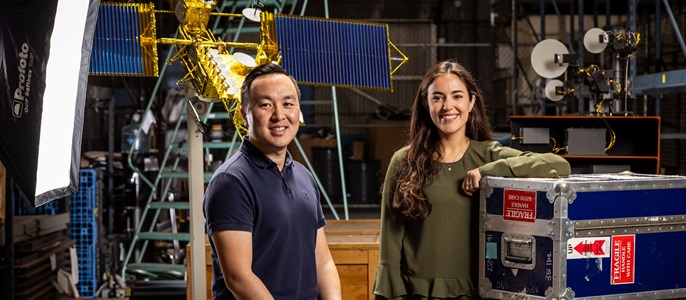Drawing on the inspiration he felt as a kid seeing the Apollo missions, Brian launched the Space Explorers club to teach students about rocketry.
By the Numbers: A Case-by-Case Basis

Kendra Kastelan
Before Northrop Grumman’s solid rocket motors reach the skies, the hydrotesting team in Clearfield, Utah, ensures they will.
“Hydrotesting tests the strength and limits of all our solid rocket motor cases to guarantee our products will withstand the pressures and stresses of flight,” said Kolton Hanson, engineering technician.
“Our job is to prove to our customer that our product is going to be successful.”
And that is just what the first GEM 63XL solid rocket motors were as they boosted United Launch Alliance’s Vulcan Centaur rocket for the first time on a mission toward the moon in 2024.
The team doesn’t take the gravity of their work lightly. “We touch every case that launches,” Kolton said. “This important step verifies our hardware so missions that launch satellites for internet, go to the Moon or defend the nation are successful. It’s rewarding to be a part of that greater accomplishment.”
The Team
14 person hydrotest team are taught through on-the-job training.
150 solid motor cases per year are tested, on average.
Across 19 different solid rocket motor programs, there are four members solely dedicated to the GEM program, which has tested:
64 GEM63 cases
and 38 GEM 63XL cases
since the programs’ inception in 2015.
GEM63XL motors measure 72 feet long. Two meters longer than its GEM 63 predecessor.
The Test
8,000 gallons of water fills a composite GEM 63XL during testing.
Over 1,900 per square inch of maximum internal pressure is held for nearly 6 minutes.
Externally, the case is structurally tested using roughly 500,000 pounds of force.
Over 150 instruments are attached to the case, collecting data throughout the 40-hour testing process.
After testing and reinspection, the case is filled with propellant to become a live solid rocket motor and transported, via custom semi-truck, 2,378 miles to launch site.
The Result
On January 8, 2024, two GEM 63XL solid rocket motors lit up the night sky in Cape Canaveral, Florida.
More than 900,000 pounds of thrust was produced — nearly two-thirds of the Vulcan’s total thrust at lift-off.
87 seconds is the time it took to burn 105,900 pounds of propellant each, over 211,000 pounds in total before being pushed away.
Life at Northrop Grumman
Your work at Northrop Grumman makes a difference. Whether you want to design next-generation aircraft, harness digital technologies or build spacecraft that will return humanity to the moon, you’ll contribute to technology that’s transforming the world. Check out our career opportunities to see how you can help define possible.


Polar Partners
Hear from the team making this mission possible. The mission is a team effort, bringing together employees from across the company.

Switchboards in the Sky
Director Diane Legler ends her welcome speech to interns and college hires on her military satellite communications team with a bit of humor.